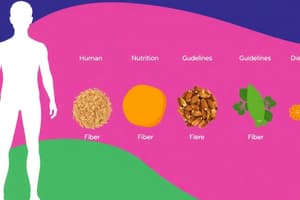Podcast
Questions and Answers
What is the primary focus of the course NURS 1115?
What is the primary focus of the course NURS 1115?
- Nutrition (correct)
- Physical Exercise
- Medical Biochemistry
- Pharmacology
Socioeconomic status has no impact on the accessibility of nutritious foods.
Socioeconomic status has no impact on the accessibility of nutritious foods.
False (B)
What are the two main methods of course assessment in NURS 1115?
What are the two main methods of course assessment in NURS 1115?
Projects and Exams
_________ factors influence food choices alongside psychological needs and social bonds.
_________ factors influence food choices alongside psychological needs and social bonds.
Match the following influences on nutrition with their descriptions:
Match the following influences on nutrition with their descriptions:
Which course book is required for NURS 1115?
Which course book is required for NURS 1115?
Cultural and religious dietary practices can determine acceptable food choices.
Cultural and religious dietary practices can determine acceptable food choices.
Nutrition encompasses processes like food consumption, digestion, absorption, ________, and excretion.
Nutrition encompasses processes like food consumption, digestion, absorption, ________, and excretion.
Which macronutrient provides the most energy per gram?
Which macronutrient provides the most energy per gram?
Complete proteins lack one or more essential amino acids.
Complete proteins lack one or more essential amino acids.
What is the primary function of vitamins in the body?
What is the primary function of vitamins in the body?
Lipids include triglycerides, phospholipids, and ______.
Lipids include triglycerides, phospholipids, and ______.
Match the following nutrient categories with their functions:
Match the following nutrient categories with their functions:
Which type of vitamin is stored in body fat and may cause toxicity when excessively consumed?
Which type of vitamin is stored in body fat and may cause toxicity when excessively consumed?
Water-soluble vitamins are stored in the body and can accumulate to toxic levels.
Water-soluble vitamins are stored in the body and can accumulate to toxic levels.
Name one source of complete proteins.
Name one source of complete proteins.
Which of the following is NOT a type of macronutrient?
Which of the following is NOT a type of macronutrient?
Water is classified as a macronutrient.
Water is classified as a macronutrient.
What nutrient is primarily responsible for energy production and storage?
What nutrient is primarily responsible for energy production and storage?
The primary role of _____ is to provide structural support and facilitate chemical reactions.
The primary role of _____ is to provide structural support and facilitate chemical reactions.
Match the essential nutrients with their primary functions:
Match the essential nutrients with their primary functions:
Which of the following foods is a good source of unsaturated fats?
Which of the following foods is a good source of unsaturated fats?
Micronutrients are needed in larger amounts compared to macronutrients.
Micronutrients are needed in larger amounts compared to macronutrients.
What are the two main types of fiber?
What are the two main types of fiber?
_____ are organic compounds required for metabolic processes and can be water-soluble or fat-soluble.
_____ are organic compounds required for metabolic processes and can be water-soluble or fat-soluble.
What is the role of fibres in the diet?
What is the role of fibres in the diet?
Home care nutrition support is unnecessary for homebound patients.
Home care nutrition support is unnecessary for homebound patients.
Name one key role of nurses in nutrition care.
Name one key role of nurses in nutrition care.
The recommended daily water intake for men is _____ liters.
The recommended daily water intake for men is _____ liters.
Which nutrient is primarily provided by legumes and nuts?
Which nutrient is primarily provided by legumes and nuts?
Fruits mainly provide protein as a key nutrient.
Fruits mainly provide protein as a key nutrient.
Match the following essential nutrients to their sources:
Match the following essential nutrients to their sources:
List two examples of dark green leafy vegetables.
List two examples of dark green leafy vegetables.
The multimix principle emphasizes combining different ______ to maximize nutritional value.
The multimix principle emphasizes combining different ______ to maximize nutritional value.
Match the types of food mixes to their examples:
Match the types of food mixes to their examples:
Which of the following are NOT sources of carbohydrates?
Which of the following are NOT sources of carbohydrates?
Recipe calculations can help assess the nutritional value of composite dishes.
Recipe calculations can help assess the nutritional value of composite dishes.
What is the primary energy source in the human body?
What is the primary energy source in the human body?
Nuts and legumes are good sources of ______ and fiber.
Nuts and legumes are good sources of ______ and fiber.
Which factor evaluates nutrient retention after cooking?
Which factor evaluates nutrient retention after cooking?
Complex carbohydrates are composed solely of monosaccharides.
Complex carbohydrates are composed solely of monosaccharides.
Name two types of simple carbohydrates.
Name two types of simple carbohydrates.
The preferred method for recipe calculations is the ______ method.
The preferred method for recipe calculations is the ______ method.
Which of the following nutrients are NOT commonly found in foods from animals?
Which of the following nutrients are NOT commonly found in foods from animals?
Flashcards
What is nutrition?
What is nutrition?
The study of how living organisms use food to support life, including processes like digestion, absorption, metabolism, and excretion.
What influences our food choices?
What influences our food choices?
Social and family dynamics, religious and ethical beliefs, and economic factors affect what people eat and how.
How does culture influence nutrition?
How does culture influence nutrition?
Traditions, values, and beliefs impact people's dietary habits, including what they eat, how they prepare meals, and how they eat together.
How do economic factors affect nutrition?
How do economic factors affect nutrition?
Signup and view all the flashcards
How do psychological and emotional factors influence nutrition?
How do psychological and emotional factors influence nutrition?
Signup and view all the flashcards
What is nutritional balance?
What is nutritional balance?
Signup and view all the flashcards
How do social and family dynamics influence nutrition?
How do social and family dynamics influence nutrition?
Signup and view all the flashcards
How do cultural and religious practices influence nutrition?
How do cultural and religious practices influence nutrition?
Signup and view all the flashcards
What is food?
What is food?
Signup and view all the flashcards
What are nutrients?
What are nutrients?
Signup and view all the flashcards
What are macronutrients?
What are macronutrients?
Signup and view all the flashcards
What are micronutrients?
What are micronutrients?
Signup and view all the flashcards
What are vitamins?
What are vitamins?
Signup and view all the flashcards
What are minerals?
What are minerals?
Signup and view all the flashcards
What are carbohydrates?
What are carbohydrates?
Signup and view all the flashcards
What are proteins?
What are proteins?
Signup and view all the flashcards
What are lipids (fats)?
What are lipids (fats)?
Signup and view all the flashcards
What is fiber?
What is fiber?
Signup and view all the flashcards
What is water?
What is water?
Signup and view all the flashcards
What is nutritional screening?
What is nutritional screening?
Signup and view all the flashcards
What is a nurse's role as a liaison?
What is a nurse's role as a liaison?
Signup and view all the flashcards
What is a nurse's role as a nutrition resource?
What is a nurse's role as a nutrition resource?
Signup and view all the flashcards
What is a nurse's role in reinforcing nutrition counseling?
What is a nurse's role in reinforcing nutrition counseling?
Signup and view all the flashcards
What is an enzyme?
What is an enzyme?
Signup and view all the flashcards
What are essential amino acids?
What are essential amino acids?
Signup and view all the flashcards
What are triglycerides?
What are triglycerides?
Signup and view all the flashcards
What is a vitamin?
What is a vitamin?
Signup and view all the flashcards
What are fat-soluble vitamins?
What are fat-soluble vitamins?
Signup and view all the flashcards
What are major minerals?
What are major minerals?
Signup and view all the flashcards
What are trace minerals?
What are trace minerals?
Signup and view all the flashcards
Multimix Principle
Multimix Principle
Signup and view all the flashcards
Double Mix
Double Mix
Signup and view all the flashcards
Triple Mix
Triple Mix
Signup and view all the flashcards
Quadri-Mix
Quadri-Mix
Signup and view all the flashcards
Food Composition Tables (FCT)
Food Composition Tables (FCT)
Signup and view all the flashcards
Recipe Calculations
Recipe Calculations
Signup and view all the flashcards
Yield Factor
Yield Factor
Signup and view all the flashcards
Edible Coefficient
Edible Coefficient
Signup and view all the flashcards
Retention Factor
Retention Factor
Signup and view all the flashcards
Summing of Raw Ingredients
Summing of Raw Ingredients
Signup and view all the flashcards
Ingredient Method
Ingredient Method
Signup and view all the flashcards
Total Recipe Method
Total Recipe Method
Signup and view all the flashcards
Mixed Method
Mixed Method
Signup and view all the flashcards
Carbohydrates
Carbohydrates
Signup and view all the flashcards
Carbohydrate Metabolism
Carbohydrate Metabolism
Signup and view all the flashcards
Study Notes
Course Information
- Course: NURS 1115: Nutrition
- Type: Lecture
- Instructor: Dr. Andrew S. Dhanoo
- Prerequisites: NURS 1110 Biochemistry
- Credits: 2
- Textbook 1: Dudek, Susan G. Nutrition Essentials for Nursing Practice (any edition).
- Textbook 2: Shivananda Nayak B. Handbook of Applied Biochemistry, Nutrition, and Dietetics for Nursing and Allied Health Students, 5th Edition.
- Cohort 1: Mondays 1-3 pm, Room 4
- Cohort 2: Fridays 1-3 pm, Room 2
- Assessments:
- Projects (30%): 15% Recipe Calculation, 15% Community/Education
- Midterm Exam (10%): Multiple Choice Questions (MCQ) and Short Answer
- Final Exam (60%): MCQ, Short Answer, and Essay Questions
- Course Outline: Fundamentals of Human Nutrition, Nutrition Across the Lifespan, Nutrition-Related Health Issues, Cultural, Economic, and Educational Influences on Nutrition
Introduction to Nutrition
- Definition of Nutrition: The biochemical and physiological process of using food to support life, encompassing consumption, digestion, absorption, metabolism, and excretion.
Key Influences on Nutrition
- Cultural Influences: Traditions, values, and beliefs impact dietary choices.
- Economic Factors: Socioeconomic status affects access to nutritious foods.
- Pleasure and Emotions: Psychological and emotional factors influence food choices.
- Nutritional Balance: A balanced intake of different food types is crucial.
- Social Dynamics: Social networks, family, and peers influence eating habits.
- Cultural Practices: Religious and ethical restrictions influence dietary choices.
- Food Preferences: Taste preferences motivate food choices.
- Psychosocial Aspects: Emotions, stress, and mental health affect eating.
- Chronic Disease Management: Diet plays a crucial role in managing chronic illnesses.
- Developmental Needs: Nutritional needs change at different life stages.
Roles of Nurses in Nutrition Care
- Nutritional Screening: Identifying patients at nutritional risk.
- Liaison: Connecting patients with various healthcare providers (e.g., dietitians, physicians).
- Nutrition Resource: Providing nutritional guidance, especially when dietitians aren't available.
- Reinforcement: Supporting dietary advice provided by others.
- Discharge Instructions: Offering post-discharge nutritional recommendations.
- Home Care Support: Assisting with nutrition for homebound patients.
- Monitoring and Documentation: Tracking nutritional progress.
Important Nutritional Definitions
- Food: Any nutritious substance consumed by organisms for life and growth.
- Nutrient: Any chemical compound in food needed for energy, reactions, and maintaining health.
- Macronutrients: Nutrients needed in large amounts (grams) for energy and structure: carbohydrates, proteins, and fats.
- Micronutrients: Nutrients needed in smaller amounts (milligrams or micrograms): vitamins and minerals.
- Vitamin: Organic compounds crucial for metabolic processes, immunity, and overall well-being.
- Mineral: Inorganic elements vital for various bodily functions, e.g., bone formation and nerve transmission.
Nutrient Recap: The 7 Essential Nutrients
Carbohydrates
- Definition: Organic compounds of carbon, hydrogen, and oxygen (1:2:1 ratio).
- Functions: Energy production, protein sparing, reducing ketosis, supporting gut health.
- Sources: Grains, fruits, vegetables, dairy, sugars.
Proteins
- Definition: Major structural and functional components of body tissues, composed of amino acids.
- Functions: Body structure (muscles, skin), enzymes, hormones, antibodies, fluid balance, acid-base balance, energy source.
- Sources: Complete proteins (animal products, soy), incomplete proteins (legumes, nuts, grains).
Lipids (Fats)
- Definition: Organic compounds insoluble in water, including triglycerides, phospholipids, and sterols.
- Types: Good fats (unsaturated), bad fats (saturated, trans).
- Functions: Energy, insulation, protection, vitamin absorption, cell structure.
- Sources: Animal fats, plant oils, nuts, seeds, fish.
Vitamins
- Definition: Organic substances regulating bodily functions and supporting metabolism.
- Categories: Fat-soluble (A, D, E, K), water-soluble (B vitamins, vitamin C).
- Functions: Coenzymes, antioxidants, therapeutic uses (e.g., Vitamin A in acne treatment).
Minerals
- Definition: Essential inorganic elements for various physiological functions.
- Categories: Major (e.g., calcium, magnesium), trace (e.g., iron, zinc).
- Functions: Bone health, muscle function, nerve transmission, enzyme activation.
Fiber
- Definition: Indigestible plant components promoting digestive health.
- Types: Soluble (slows digestion, reduces cholesterol), insoluble (increases stool bulk, prevents constipation).
- Sources: Fruits, vegetables, whole grains, legumes.
Water
- Definition: Essential for life, acting as a solvent and medium for biological processes.
- Functions: Cell structure, temperature regulation, nutrient transport, lubrication.
- Recommendations: Men (3.7 liters/day), Women (2.7 liters/day).
Food Group Theories
- Food Group Classifications: Categorizing foods for balanced diet planning.
- Staples: Cereals, starchy fruits, roots, tubers. (Carbohydrates, vitamins, minerals, fiber)
- Legumes and Nuts: Peas, beans, nuts. (Protein, carbohydrates, calcium, iron, fiber)
- Vegetables: Leafy greens, yellow veggies. (Vitamins, minerals, fiber)
- Fruits: Mangoes, guavas, oranges, etc. (Carbohydrates, vitamins C & A, minerals, fiber)
- Foods from Animals: Meat, fish, eggs, dairy. (Protein, iron, B vitamins, fat-soluble vitamins, fat)
- Fats and Oils: Vegetable oils, butter, margarine. (Fats, vitamin E, A, D (in some cases))
Multimix Principle
- Multimix Principle: Combining food groups to maximize nutritional value, vital where variety is limited.
- Double Mix: Combining two food groups (e.g., rice and peas).
- Triple Mix: Combining three food groups (e.g., rice, peas, and carrots).
- Quadri-Mix: Combining four food groups (e.g., dumplings, beef, beans, carrots).
Food Composition Tables (FCT)
- Food Composition Tables: Databases providing detailed nutritional information about foods, including macronutrients, micronutrients, and calories.
- Sources: Pan-American Health Organization, FAO, European Food Databases, Asian Food Databases.
Recipe Calculations
-
Purpose: Evaluating nutritional value of composite dishes, standardizing recipes and creating dietary guidelines.
-
Reasons to Use: Consistent nutritional analysis; national/regional surveys, individualized dietary plans, food labels.
-
Steps: Identifying ingredients, applying factors (yield, edible coefficient, retention), calculations, and documentation.
-
Methods: Summing raw ingredients, ingredient-level calculations, recipe-level calculations, mixed method (combining factors for accuracy).
-
Common Errors: Forgetting cooking additives, wrong factor application, incomplete data.
Nutrient Recap: Detailed Explanations of Key Nutrients
Carbohydrates
- Functions: Energy production, storage, protein-sparing, reducing ketosis, gut health, biological recognition, flavor enhancement.
- Types: Simple (monosaccharides, disaccharides), complex (starches, fibers).
- Sources: Grains, fruits, vegetables, dairy, sugars.
Proteins
- Functions: Structure, enzymes, hormones, antibodies, fluid balance, acid-base balance, transport, energy when necessary.
- Types: Complete (essential amino acids), incomplete (missing essential amino acids).
- Sources: Animal products, soy, beans, legumes, nuts, seeds, grains.
Lipids (Fats)
- Functions: Energy storage, insulation, protection, vitamin absorption, cell structure, hormone regulation.
- Types: Triglycerides, phospholipids, sterols.
- Sources: Animal fats, plant oils, fish.
Vitamins
- Categories: Fat-soluble (A, D, E, K), water-soluble (B vitamins, vitamin C).
- Functions: Metabolic regulation, antioxidants, therapeutic uses.
Minerals
- Categories: Major (e.g., calcium, phosphorus), trace (e.g., iron, zinc).
- Functions: Supporting bone health, muscle function, nerve transmission, enzyme activation.
Studying That Suits You
Use AI to generate personalized quizzes and flashcards to suit your learning preferences.
Description
Test your knowledge on the fundamentals of human nutrition and its impact across the lifespan. This quiz covers key concepts from the course NURS 1115, including nutrition-related health issues and cultural influences on dietary practices. Prepare for assessments focused on recipe calculations and community education.




